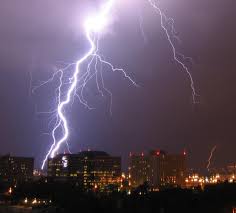Thunderstorms are very dangerous because they produce lightning which can cause death. Over the 30 years from 1984 to 2013, there were on average 51 deaths per year, although the number has been on the decline since 2006. This makes lightning one of the top three killers storm-related killers, and injures hundreds more each year.
Other dangers associated with thunderstorms include tornadoes, high winds, hail (as large as golf balls or baseballs), and flash floods. Flash floods alone are responsible for 140 fatalities each year, more than other associated hazard. In the western U.S dry thunderstorms produce rain that evaporates before it reaches the ground. The lightning from all thunderstorms can reach the ground and start wildfires.
Facts About Thunderstorms
- They may occur as single storms, in clusters, or in lines
- Many severe storms occur in a single location for an extended period of time
- Heavy rain is usually produced for a brief period from 30 minutes to an hour
- Warm, humid conditions often occur as storms develop
Ways To Prepare For A Thunderstorm
- Create an Emergency Kit
- Have a family communication plan
- Remove dead or rotting trees and branches from near your house which could cause injury or damage if they fall
- Stay indoors and postpone outdoor activities
- Secure objects that could blow away or cause damage in high winds
- Get indoors (home, building, non-convertible automobile)
- Shutter windows and secure outside doors. Close window blinds, shades, and curtains if you do not have shutters.
- Unplug electronic equipment before the arrival of the storm
Lightning Facts
- The unpredictability of lightning makes it very risky
- Lightning can occur as far as 10 miles from a thunderstorm, and usually strike outside of heavy rain.
- Most lightning injuries and deaths occur during summer afternoons and evenings
- The probability of being struck by lightning is 1 in 600,000 but can be reduced by taking safety precautions
- Lightning strike victims need immediate medical attention
Lighting Risks Outdoors
| IF YOU ARE: | THEN: |
| In a forest | Seek shelter in a low area under a thick growth of small trees. |
| In an open area | Go to a low place such as a ravine or valley. Be alert for flash floods. |
| On open water | Get to land and find shelter immediately. |
Thunderstorm weather terms:
Severe Thunderstorm Watch – Severe thunderstorms are likely to occur. Watch the weather outside, listen to NOAA weather radio, or local radio/television for information
Severe Thunderstorm Warning – indicate imminent danger to life and property to those in the path of the storm
Sources: FEMA, NOAA

